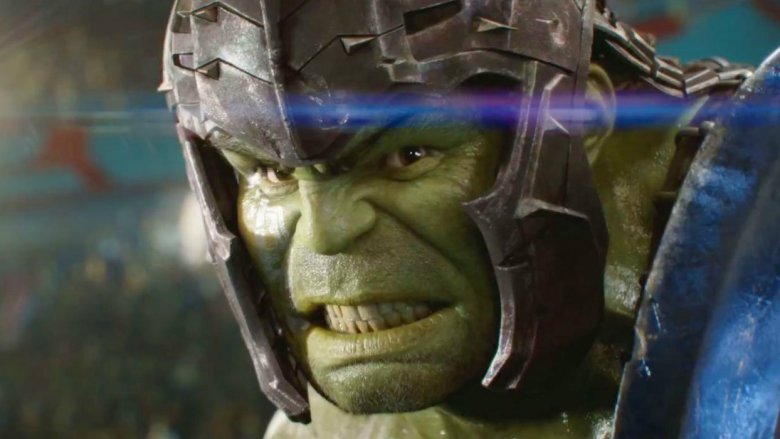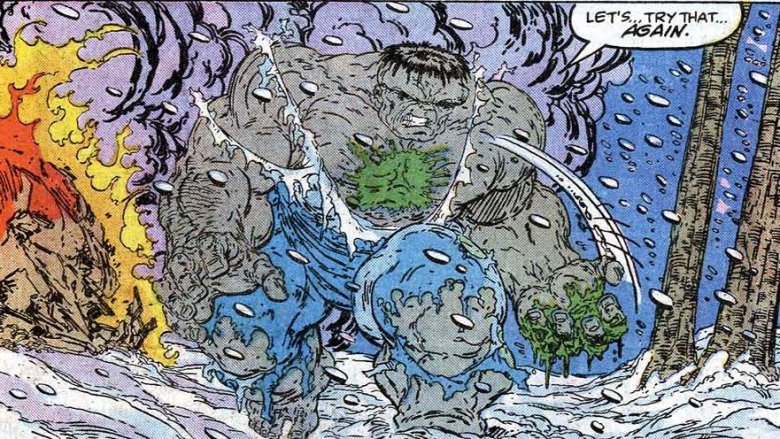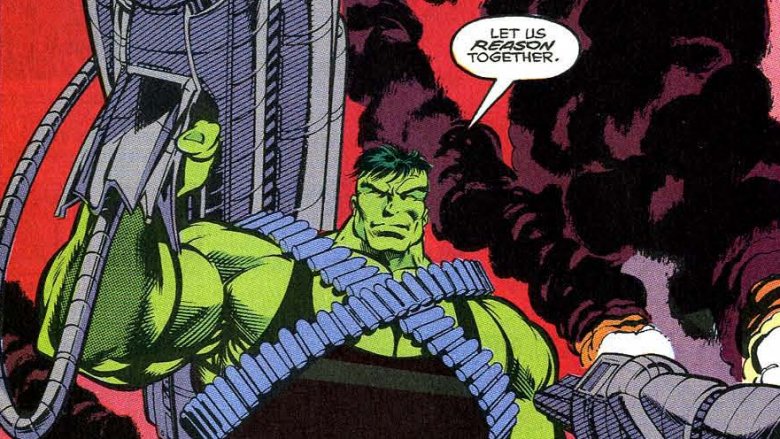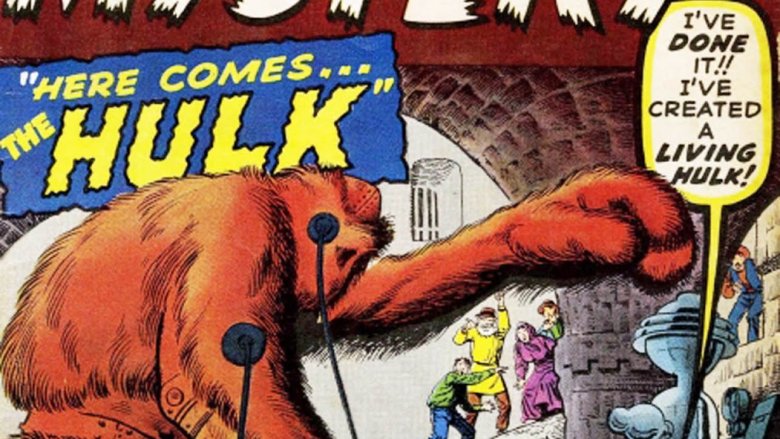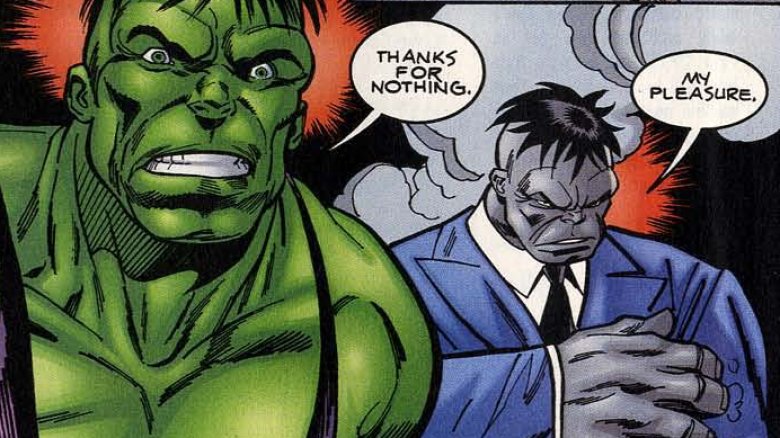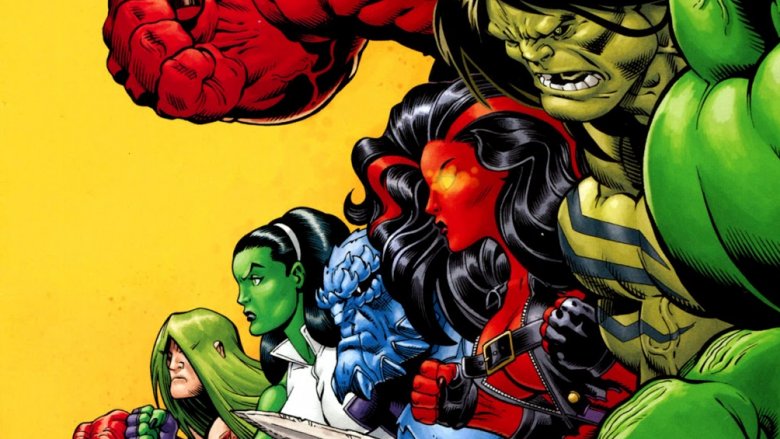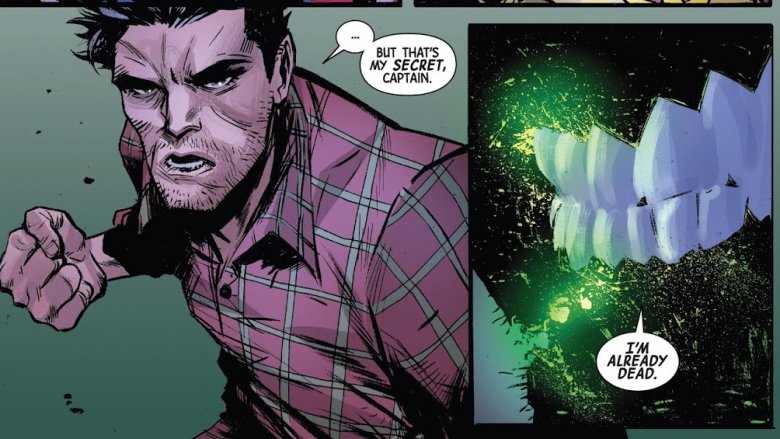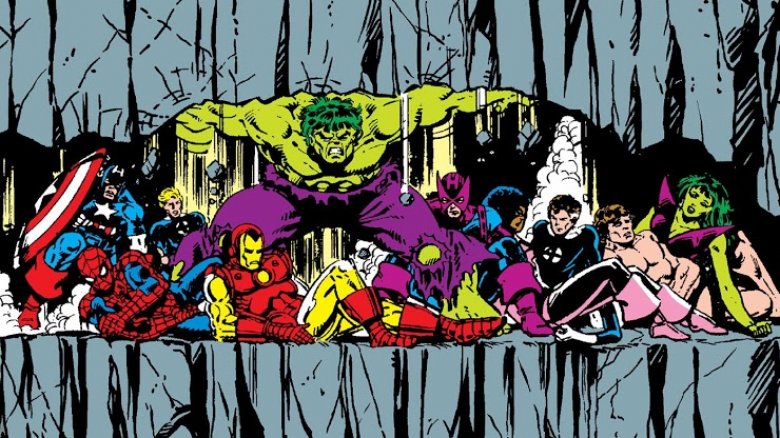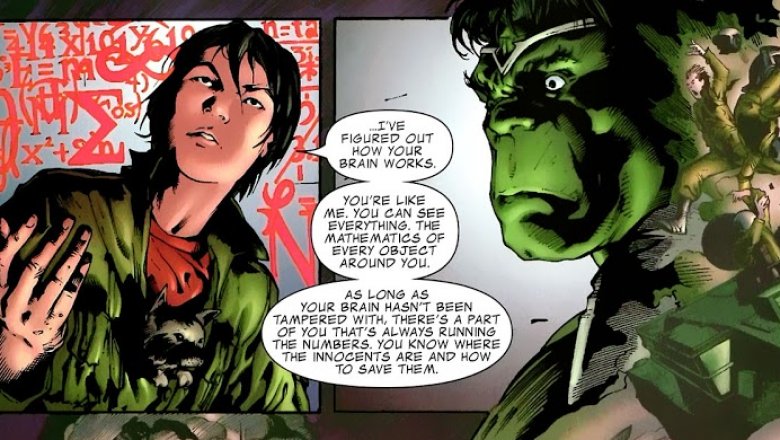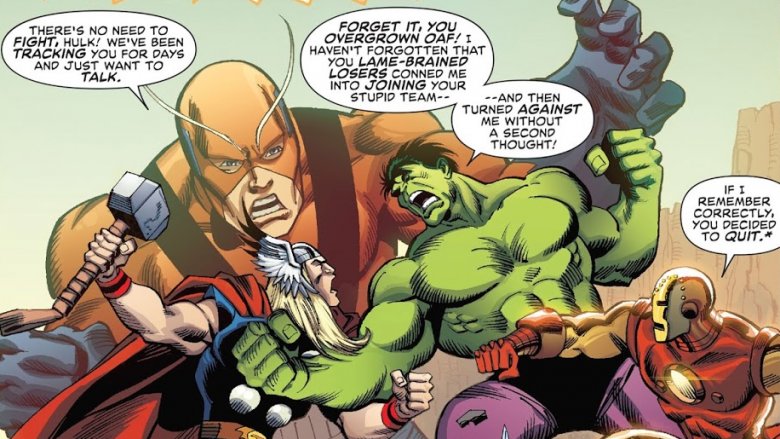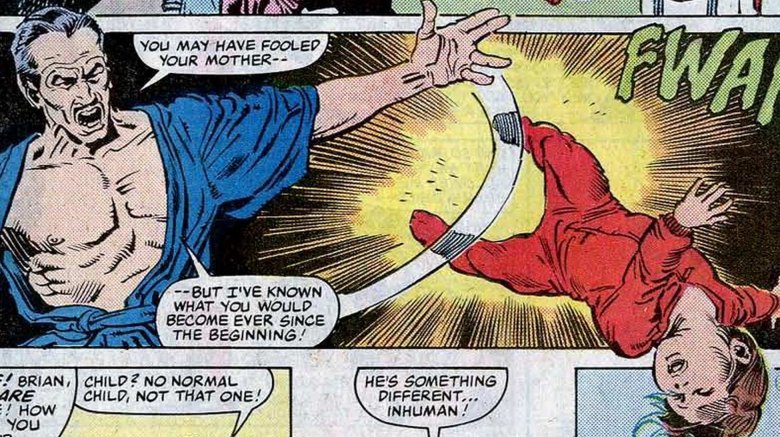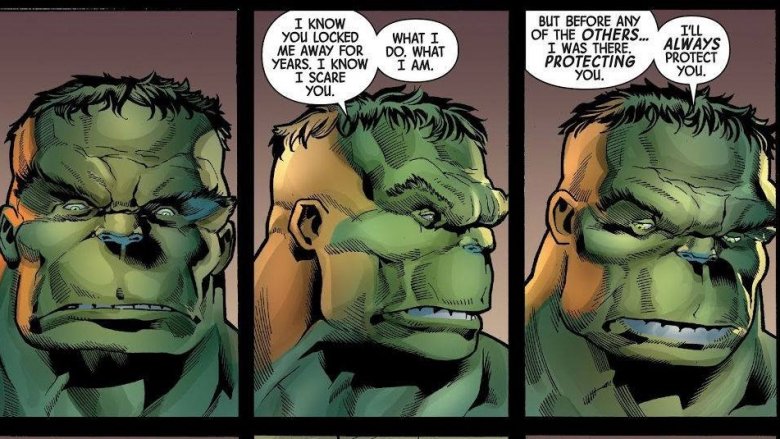False Facts About The Hulk You Always Thought Were True
Perhaps more than any other household name superhero, the Hulk's depictions in media vary widely. Lou Ferrigno's Hulk of the '70s Incredible Hulk TV show is nothing like the green guy we see stomping around the MCU, and neither truly mirrors the Hulk of the comics (though the MCU one gets a lot closer). As a result, there are a lot of misunderstandings about the character. The general consensus appears to be that as soon as Banner gets ticked off, he turns into a big, dumb, strong meathead who's useful as long as he's punching the right people.
But the Hulk is capable of much more than many fans realize, and not just in terms of power, but in depth of character. The Green (usually, but not always) Goliath has a complex history, with tragic aspects that are directly responsible for his tendency to smash. He's impossible to kill, has a mind much more complicated than most realize, and his legacy has birthed a veritable army of Hulks in the Marvel Universe. Keep reading to learn the truth about all this, and the false facts about the Hulk you always thought were true.
That he can be killed
In part because a major reference point for many remains the '70s live-action Incredible Hulk TV show starring Bill Bixby and Lou Ferrigno — whose man-monster was nowhere near as powerful as the comic book or movie versions — there can be quite a bit of bad information about just how unkillable the Hulk truly is.
The Hulk possesses a healing factor that makes Wolverine's look like a band-aid. He's survived having all his flesh flayed from his bones, getting used like a pincushion by Wolverine, and standing in the heart of one of the Human Torch's deadly Nova blasts. In 2002's Incredible Hulk: The End, it takes Hulk less than 20 minutes for his body to reconstitute after being devoured by mutated cockroaches. In 2005's Incredible Hulk #77 we learn that his body has evolved to the point where he can safely extract oxygen from water, allowing him to stay underwater as long as he wants. Just before the classic Planet Hulk storyline, we learn the Hulk can survive in space without oxygen.
When the Hulk finally returns from the dead in 2018's Avengers #684, we learn that even death can't stop the Hulk. Hulk's new Immortal Hulk series follows after his return and his new status quo means even if you can kill him, he'll just come back the next night. In 2019's Immortal Hulk #8, the Hulk is dismembered and his respective body parts are placed in separate jars. He still comes back.
That he's stupid
Of the things the Incredible Hulk is known for, his intelligence isn't real high on the list. But calling the Hulk stupid is short-sighted for a few reasons. For one thing, there are so many versions of the character, and many of them are literal rocket scientists. In his origin story, the Hulk is by no means a Mensa candidate, but he isn't stupid — he's thuggish, but speaks in complete sentences. The grey or "Joe Fixit" Hulk is clever and crafty, outthinking his foes as often as he overpowers them. The merged or so-called "Professor" Hulk shares Banner's genius, as does the "Doc Green" Hulk of the 2014 Hulk series and the evil Maestro, who originates in a dystopian future.
On the other hand, even the supposedly less intelligent versions of the character sometimes only seem stupid because we can't see through their eyes. For example, in 2012's Indestructible Hulk series, writer Mark Waid hardly bothered giving the Hulk any dialogue at all, but the character still isn't stupid. Here, it seems more that the Hulk is a force of nature — a creature of action completely beyond words. If you're a giant green titan who can survive in the heart of a volcano, what do you have to say to anyone (besides, you know, "Someone help me out of this volcano — I'm fine but it's uncomfortable")?
That he's Marvel's first Hulk
Not only was the Bruce Banner not the first Marvel Hulk, he wasn't even the second... or the third.
Hulk version 1.0 was a giant robot in 1960's Strange Tales #75. Next came Xemnu, the "Living Hulk." Xemnu was a giant, furry alien. In spite of some kind of metal cap bolted to his skull (or perhaps because of it), Xemnu could control the minds of multiple humans at once. Later, after the more Incredible Hulk became a Marvel superhero, Xemnu went from being the "Living Hulk" to the "Living Titan."
The final Hulk to precede the one we all know and love was a sea monster in 1961's Tales to Astonish #21. Kind of. See, the Hulk of "The Silent Screen" is a character in a movie. The story fools you into thinking you're looking at an audience watching a movie called The Hulk (Eric Bana is nowhere in sight). When the sea monster steps out of the movie screen, you learn a different audience is watching a movie of a sea monster stepping out of a movie screen and scaring a theater full of people. But it doesn't end there. You eventually learn you are watching an audience that is watching another audience who watches still another audience, with the final audience being the ones freaking out about the sea monster stepping out of the movie screen.
That he's always green
When the Hulk first smashed his way into the panels of Marvel Comics in 1962's Incredible Hulk #1, he was grey-skinned instead of green. Urban legends have circulated over the years about why his skin coloring was changed to green as early as the series' second issue. In 2003, Starlog Magazine wrote that Stan Lee chose grey over the suggestions of colorist Stan Goldberg, who argued grey was too difficult to keep a consistent shade. Lee wasn't convinced until Hulk #1 was released and he saw what Goldberg was talking about.
The grey Hulk got a new lease on life in the mid '80s. Writer/artist Al Milgrom resurrected the grey guy in 1986's Incredible Hulk #324, and when Peter David took over writing the title, he ran with it. The grey, crafty Hulk revitalized the series. Because of a now-classic storyline that saw the Hulk working for a casino owner/mobster in Las Vegas, the grey Hulk is now usually referred to by the name they called him in Sin City: Joe Fixit.
In 2008, writer Jeph Loeb and artist Ed McGuinness rebooted the Hulk title with a malevolent Red Hulk. Initially the Red Hulk's identity is unknown, but is eventually revealed to be Banner's longtime enemy General Thaddeus "Thunderbolt" Ross. Another officer, Robert Maverick, later assumes the title and powers of the Red Hulk until the Immortal Hulk drains the gamma radiation out of him in Avengers #685.
That there's only one Hulk
Particularly since the 2008 birth of the Red Hulk, there's been a distinct change in Marvel's grammar. The Hulk used to be the Hulk. Now Marvel characters usually refer to "a" Hulk. For example, in April 2019's Dead Man Logan #6, the mutant Forge stands before a decapitated Maestro and says, "It's not often I get the chance to study an actual Hulk."
That's because there are a lot more Hulks on Marvel's Earth, not even counting the different versions of Hulk that Banner transforms into. There's the Red Hulk. There's Banner's cousin Jen Walters, a.k.a. She-Hulk. Banner's wife Betty was Red She-Hulk for a time. There is actually a third She-Hulk named Lyra; she comes from a dystopian reality where men and women are in a constant state of war, and she is technically Bruce Banner's daughter. There's Doc Samson, the green-haired therapist who enjoys a degree of the Hulk's strength. Rick Jones was once the blue-scaled A-Bomb. He was "cured" by Doc Green and later died in Secret Empire, but in the Marvel Universe, death is about as permanent as hair dye.
There's a son of Hulk and another son of Hulk. There's Brawn; a.k.a. Amadeus Cho, formerly the "Totally Awesome" Hulk. There was a teen Abomination in Superior Iron Man. There's just... there are a lot of Hulks, guys. More than a few.
That anger is Banner's only trigger
The usual understanding of the Banner/Hulk relationship is that there's no reason to worry about Bruce Banner until he gets angry. If Banner could find away to eliminate all rage from his life, no one would ever have to worry about "the Other Guy" again.
But that isn't always the case. Back in 1962's Incredible Hulk #1, the Hulk burst free of Banner's flesh at night, and only at night. In the late '80s writer Peter David revived this day/night dynamic. He also stressed that Hulk was more than just a manifestation of Banner's rage — he represented Banner's survival instinct. In David's finale on Incredible Hulk, 1998's Incredible Hulk #467, Banner attempts suicide several times in the wake of his wife's death, including a swan dive off the Empire State Building. Each time, the Hulk shows up to save him. In Incredible Hulk: The End when Banner is left as literally the only human on Earth, again Banner tries to end things multiple times and the Hulk keeps intervening. You don't even have to read comics to be familiar with this. In 2012's Avengers, Bruce Banner (Mark Ruffalo) confesses to the team he attempted suicide, but the Hulk emerged and stopped him.
Al Ewing, writer of Immortal Hulk, brought back the day/night dynamic more recently and added a brand new trigger for the transformation: death. Bruce Banner can die during the day and he will rise that night as the Hulk.
That he can only get so strong
When it comes to the question of how strong the Hulk is, there's no definitive answer. You might think Bruce Banner gets angry, he turns into the Hulk, and that's it. But that's not the case. Hulk's strength continues to increase, even after the transformation, along with his anger. The angrier he gets, the stronger he gets. That's why in 2008's Incredible Hulk, while the Abomination starts out clearly outmatching the Hulk, the Green Goliath eventually gets strong enough to defeat his rival. As long as he's on his feet and he's fighting, the Hulk keeps getting stronger without any ceiling.
This is why the wilder versions of the Hulk tend to do more damage. When the green guy has a degree of Banner's intelligence, he isn't always willing to let himself get angry. The '80s saw a period in which Banner gained control of his transformations. In these stories, old enemies are more difficult to handle because Banner doesn't allow himself to get angry. Ironically, it's during this period that the Hulk achieves one of his most memorable feats of strength — he braces a mountain range on his back In 1984's Secret Wars #4, saving most of Marvel's heroes. It's likely it wouldn't have been possible without the support of Reed Richards, who keeps antagonizing and insulting Hulk in order to keep him strong enough to hold back the rock while Richards finds a way to escape.
That he's a killer
In 2006's New Avengers: Illuminati #1, writer Brian Michael Bendis showed the various heroes of the Illuminati planning to exile the Hulk into space. Iron Man mentions a recent fight between the Hulk and the Thing in Fantastic Four, as well as referencing all the supposed fatal victims of the Hulk's rampages. Some fans bristled at this, arguing that the Hulk didn't kill. Later, during World War Hulk, writer Greg Pak seemed to side with the fans.
In Incredible Hulk #110, which crossed over with World War Hulk, Pak revealed a secret the Hulk had apparently been harboring for years. The young Amadeus Cho says he knows how Hulk's managed to keep from killing innocent bystanders during his rampages. Cho is a genius with the ability to predict — among other things — exactly where objects will land and how they will affect one another. If there's, say, a spot on a helicopter where hitting it just right with a No. 2 pencil could take it down, then Cho knows where that spot is, exactly how much pressure to apply, and at what angle to apply it. Confronting the Hulk, Cho theorizes the Hulk's mind works the same way as his, and the Green Goliath's stunned silence confirms Cho's suspicions. The Hulk's rampages don't kill, in other words, because the Hulk always knows how to stop that from happening.
That he's a team player
Regardless of the team and regardless of which version of the Hulk is dominant, the Hulk does not play well with other superheroes. He'll help them, but the alliance is always an uneasy one. In spite of helping to found the Avengers, for example, the Hulk is hardly considered an honored alumnus. He's fought the team dozens of times and he'll fight them again. Their relationship is so contentious that Marvel released the mini-series Hulk Smash Avengers in 2012, showing era-by-era how intense the rivalry could be between the Hulk and his former teammates.
The Hulk's contempt for other superheroes is obvious even when one of his more intelligent personas is in charge. For example, the "Professor" Hulk had the reins during Jim Starlin's Infinity trilogy that included 1991's Infinity Gauntlet, 1992's Infinity War, and 1993's Infinity Crusade. The Professor Hulk is known for his intelligence and his relative calm, yet still he spends his entire time with the assembled heroes insulting them. He isn't much better (he's maybe even a little worse) when Banner holds the reins completely during the game-changing Secret Wars mini-series.
Whether he's green or grey, whether he talks like a caveman or like a Nobel prize candidate, you can be sure of one thing about the Hulk: whoever you are, he probably doesn't like you.
That he's part of the Storm of the Orphans
Parents die, an orphan is made, and a hero is born — it's a cycle that can be applied to a healthy chunk of comics history's marquee superheroes. Batman, Superman, Spider-Man, Daredevil, Black Panther, and more all experience the violent death of a parent or parent figure in their childhood, inspiring them to become more than human. In his 2004 book Superman on the Couch, former Marvel writer and editor Danny Fingeroth calls this the "Storm of the Orphans."
This Storm is another way in which the Hulk is different from other superheroes. While his origin ties into the deaths of both of his parents, neither was murdered by a gun-toting thug in an alley. One parent was murdered by another parent. And the surviving parent? Well, Banner took care of him.
In 1982's Incredible Hulk #312, we see flashes of Bruce Banner's childhood never before revealed. We learn his father Brian regularly beat his son and his wife Rebecca, eventually beating his wife to death when she tried to run away with Bruce. In 1997's retrospective Incredible Hulk -1, we see a grown Bruce confronted by his still unstable father at Rebecca's grave. After Brian knocks his son to the ground, Bruce kicks his father, who hits his head on Rebecca's gravestone. Brian does not survive the blow, and it's never made clear if Bruce meant to kill his father or if he was just trying to protect himself.
That gamma radiation created the Hulk
Plenty of writers have written Hulk comics over the years, and each has their own interpretations. But ever since Incredible Hulk #312 showed us Bruce Banner's tortured childhood, at least one thing has remained constant: the Hulk was with Bruce Banner long before he was exposed to gamma rays. The gamma bomb just opened the door. What came out of Banner had been there since he was a boy.
In 1991's Incredible Hulk #377, for the first time Bruce Banner is officially diagnosed with Multiple Personality Disorder. Both the grey and green Hulks are — according to Doc Samson — splintered personalities that Banner's subconscious created to protect him from the trauma he suffered growing up. Ever since that comic, more personalities have emerged. In Paul Jenkins' run as Incredible Hulk writer in the early aughts, we see literally dozens of Hulk personalities in Bruce Banner's mindscape, including a huge, scaled version called the Devil Hulk. It's this last one who appears to be ruling the roost in the current Immortal Hulk series.
During Planet Hulk, writer Greg Pak presented an interesting take on Hulk's view of Banner. As the Hulk's new gladiator allies tell their life stories to each other, the Hulk shares his own. When he tells them of the gamma bomb that set him loose from Banner, he not only says the bomb didn't create him — he claims Banner made the bomb to kill him.
